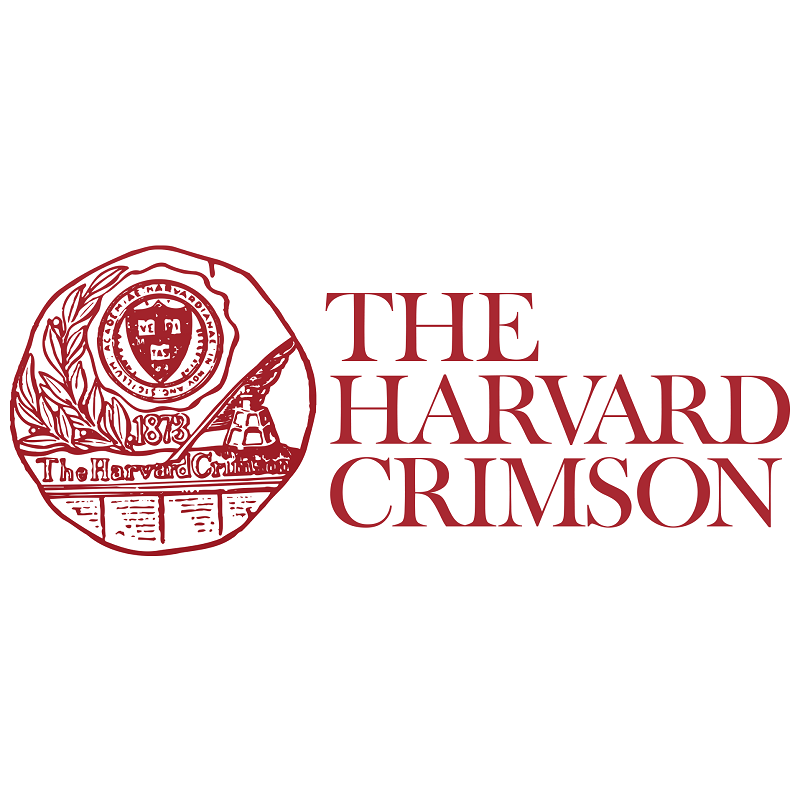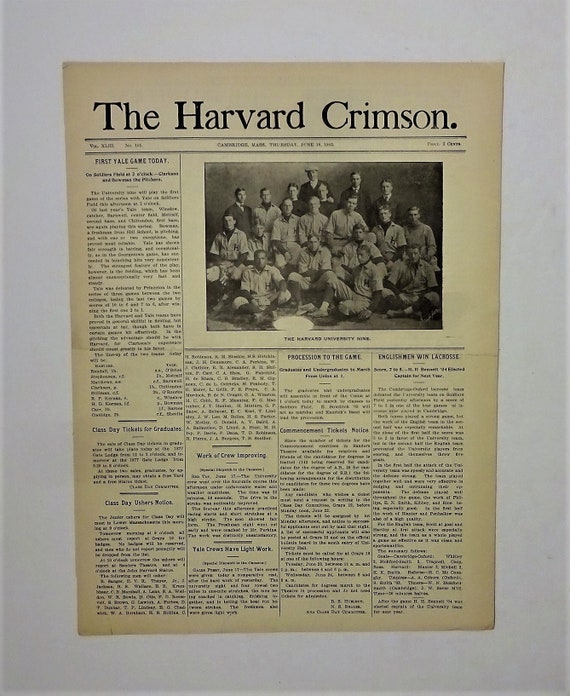When it comes to campus journalism, there's one name that stands out like a beacon of excellence: the Harvard Crimson newspaper. For over a century, this iconic publication has been shaping the world of student journalism, producing Pulitzer Prize-winning writers, and influencing generations of young journalists. But what exactly makes the Harvard Crimson so special? Let's dive into its rich history, its impact on journalism, and why it remains a cornerstone of college media.
Founded in 1873, the Harvard Crimson has become more than just a student newspaper—it’s a cultural institution. It’s where some of the brightest minds in journalism got their start, and where countless students learned the ropes of investigative reporting, opinion writing, and editorial management. The paper’s legacy is not just about its history; it’s about its continued relevance in today’s fast-paced media landscape.
As we explore the world of campus journalism, it’s impossible to ignore the Harvard Crimson's influence. From its early days as a small student-run publication to its current status as one of the most respected college newspapers in the world, the Crimson has always been at the forefront of innovation and excellence. So, buckle up, because we’re about to take you on a journey through its storied past and explore why it continues to inspire journalists around the globe.
Read also:Unlocking The Power Of Best Ssh Remoteiot Your Ultimate Guide
Origins and Founding of the Harvard Crimson
Let’s rewind to 1873, when a group of ambitious Harvard students decided to create a newspaper that would give voice to their peers. Back then, the idea of a student-run publication was groundbreaking. The Harvard Crimson started as a weekly newspaper, but its founders had big dreams. They wanted to create a platform where students could discuss the issues that mattered to them, from campus politics to social justice.
Over the years, the Crimson evolved from a humble student project into a powerhouse of journalism. In the early 20th century, it began publishing daily editions, which allowed it to cover breaking news and provide timely updates to the Harvard community. This transformation was crucial in establishing the Crimson as a credible source of information on campus.
Key Figures in the Crimson's Early Years
Several key figures played pivotal roles in shaping the Harvard Crimson’s early years. One of them was Charles William Eliot, the president of Harvard University at the time, who supported the newspaper’s mission to foster intellectual discourse among students. Another important figure was Edward Gaylord Bourne, one of the founding editors, who helped establish the paper’s reputation for rigorous reporting and editorial independence.
- Charles William Eliot: President of Harvard University and a staunch supporter of student journalism.
- Edward Gaylord Bourne: Founding editor and advocate for editorial integrity.
- Other notable contributors: A roster of writers and editors who laid the foundation for the Crimson’s success.
The Role of the Harvard Crimson in Campus Journalism
In the world of campus journalism, the Harvard Crimson is more than just a newspaper—it’s a movement. It serves as a training ground for future journalists, providing hands-on experience in reporting, editing, and publishing. Students who work for the Crimson learn the ins and outs of journalism, from writing compelling headlines to conducting in-depth investigations.
But the Crimson’s impact extends beyond its immediate readership. It plays a crucial role in shaping public opinion on campus and beyond. By covering issues such as student activism, administrative policies, and local politics, the Crimson keeps the Harvard community informed and engaged. Its coverage often sparks debates and discussions that influence decision-making at the university level.
How the Crimson Shapes Public Opinion
The Harvard Crimson’s ability to shape public opinion is one of its most powerful attributes. Through its editorials, investigative pieces, and opinion columns, the paper tackles some of the most pressing issues facing college students today. Whether it’s discussing climate change, social justice, or campus safety, the Crimson provides a platform for diverse voices and perspectives.
Read also:Securely Connect Remote Iot Vpc Raspberry Pi Download Free Your Ultimate Guide
- Editorials: Thought-provoking pieces that challenge the status quo.
- Investigative Journalism: In-depth reports that uncover truths and hold institutions accountable.
- Opinion Columns: A space for students to express their views and engage in meaningful dialogue.
Harvard Crimson's Contribution to Journalism Education
One of the most significant contributions of the Harvard Crimson is its role in journalism education. The newspaper offers students the opportunity to learn from experienced journalists and editors, many of whom have gone on to achieve great success in the field. Through internships, workshops, and mentorship programs, the Crimson helps students develop the skills they need to thrive in the competitive world of journalism.
Moreover, the Crimson’s emphasis on ethical journalism sets it apart from other student publications. It teaches students the importance of accuracy, fairness, and transparency in reporting. These values are instilled in every member of the staff, ensuring that the newspaper maintains its reputation for integrity and professionalism.
Notable Alumni and Their Achievements
The list of notable alumni who got their start at the Harvard Crimson is impressive. Pulitzer Prize-winning authors, award-winning journalists, and influential media personalities have all walked the halls of the Crimson’s newsroom. Here are just a few examples:
- Anthony Lewis: Pulitzer Prize-winning journalist and former columnist for The New York Times.
- Dorothy Wickenden: Editor of The New Yorker and former Crimson editor.
- Jeffrey Goldberg: Editor-in-chief of The Atlantic and prominent political commentator.
Challenges Faced by the Harvard Crimson
Like any institution, the Harvard Crimson has faced its share of challenges over the years. From financial difficulties to controversies surrounding its editorial decisions, the paper has had to navigate a complex landscape of issues. However, it has always managed to adapt and overcome, proving its resilience and commitment to excellence.
In recent years, the rise of digital media has posed new challenges for the Crimson. As more students consume news online, the paper has had to rethink its approach to journalism. It has embraced digital platforms, launched a website, and expanded its social media presence to reach a wider audience. These efforts have paid off, as the Crimson continues to attract a large and diverse readership.
Adapting to the Digital Age
The transition to digital journalism has been both a challenge and an opportunity for the Harvard Crimson. By embracing new technologies and platforms, the paper has been able to reach a global audience and stay relevant in today’s fast-paced media environment. Its digital initiatives include:
- A robust website that provides up-to-the-minute news and analysis.
- Social media accounts that engage with readers and promote content.
- Podcasts and video series that explore topics in depth.
The Harvard Crimson's Impact on Society
The influence of the Harvard Crimson extends far beyond the confines of the Harvard campus. Its reporting and commentary often reach a wider audience, contributing to national and international discussions on important issues. By shining a light on underreported stories and giving voice to marginalized communities, the Crimson plays a vital role in promoting social justice and equality.
Moreover, the Crimson’s commitment to ethical journalism serves as a model for other student publications. Its emphasis on accuracy, fairness, and transparency sets a standard for excellence in journalism that others strive to emulate. Through its work, the Crimson helps to ensure that the next generation of journalists is well-prepared to tackle the challenges of the future.
Case Studies of Influential Reporting
Throughout its history, the Harvard Crimson has produced numerous influential pieces of journalism. Here are a few examples that demonstrate the paper’s impact on society:
- Investigations into university policies that have led to policy changes.
- Reporting on social justice issues that sparked campus-wide movements.
- Opinion pieces that have influenced public discourse on important topics.
The Future of the Harvard Crimson
As we look to the future, the Harvard Crimson is well-positioned to continue its legacy of excellence. With a strong commitment to innovation and a dedication to ethical journalism, the paper is poised to thrive in the digital age. Its ability to adapt to changing circumstances and embrace new technologies ensures that it will remain a leader in the field of campus journalism for years to come.
Looking ahead, the Crimson plans to expand its digital presence, increase its focus on multimedia content, and continue to provide a platform for diverse voices. By doing so, it will ensure that its impact on journalism and society continues to grow.
Innovations on the Horizon
The future of the Harvard Crimson is bright, with several exciting innovations on the horizon. These include:
- Enhanced digital platforms that offer a more immersive reading experience.
- Increased use of multimedia content, such as podcasts and videos.
- Collaborations with other student publications to broaden its reach and impact.
Table: Key Facts About the Harvard Crimson
| Category | Information |
|---|---|
| Founded | 1873 |
| Publication Frequency | Daily during the academic year |
| Notable Alumni | Anthony Lewis, Dorothy Wickenden, Jeffrey Goldberg |
| Key Achievements | Pulitzer Prize-winning journalists, influential reporting, and commentary |
Conclusion: Why the Harvard Crimson Matters
In conclusion, the Harvard Crimson is more than just a student newspaper—it’s a pillar of campus journalism and a force for change. Its rich history, commitment to excellence, and impact on society make it one of the most respected publications in the world. Whether you’re a student aspiring to become a journalist or a reader seeking insightful commentary on the issues of the day, the Crimson has something to offer.
So, if you haven’t already, take some time to explore the world of the Harvard Crimson. Follow its coverage, engage with its content, and support its mission to promote ethical journalism and informed discourse. Together, we can ensure that the legacy of the Harvard Crimson continues to inspire and influence for generations to come.
Call to Action
Now that you’ve learned about the incredible legacy of the Harvard Crimson, it’s time to take action. Share this article with your friends and colleagues, leave a comment below, and subscribe to the Crimson’s newsletter to stay up-to-date on the latest news and analysis. Together, we can support the future of journalism and ensure that the Crimson’s impact continues to grow.
Table of Contents
- Origins and Founding of the Harvard Crimson
- The Role of the Harvard Crimson in Campus Journalism
- Harvard Crimson's Contribution to Journalism Education
- Challenges Faced by the Harvard Crimson
- The Harvard Crimson's Impact on Society
- The Future of the Harvard Crimson
- Table: Key Facts About the Harvard Crimson
- Conclusion: Why the Harvard Crimson Matters
- Call to Action


